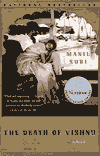| |
BOOK REVIEW
Between life and afterlife
The Death of Vishnu
by Manil Suri
By Sreeram Chaulia
 Ever
conceived of a mathematics professor who teaches exotic subjects
such as "Elements of the finite method" entering the swelling
club of Indo-English writers and carving a distinct niche for
himself in literature? Ever
conceived of a mathematics professor who teaches exotic subjects
such as "Elements of the finite method" entering the swelling
club of Indo-English writers and carving a distinct niche for
himself in literature?
Somehow, algebra and fiction appear to be oxymorons when mixed
into the same pudding. But then, the world had not expected
Lewis Carrol either. Manil Suri's literary debut seems to
vindicate the Greek philosopher Plato's ranking of mathematics
as the most creative and original science that bestows
metaphysical faculties on its practitioners.
Suri's themes in this novel are the supernatural and the
ethereal, projected through the canvas of mundane 1970s urban
India and decorated by a crafty use of Hindu mythology. A
similar menagerie of working tools was employed unsuccessfully
by Vikram Chandra in Red Earth and Pouring Rain (1997),
but then, Chandra's undoing may have lain in not being a
mathematician.
Vishnu is a homeless chronic drunkard, like thousands of poor
immigrant stragglers in Bombay city. He buys his way to an
unkempt staircase landing of a middle class apartment and makes
it his abode for the next 11 years. His relationship with the
flat owners of the building is peculiar. On one hand, he runs
errands for the Asranis, Pathaks, Jalals and Tanejas and earns
sympathy and some pocket money to get rid of "the rigors of
sobriety" (p.18), and on the other hand his lies, tantrums and
nocturnal ways give rise to notoriety that often leads the
families to curse in his name and grumble about bearing his
burden.
When Vishnu falls terminally ill, Mrs Asrani throws up her hands
and rules out her henpecked husband bearing the expenses of
calling an ambulance: "What good will it do now anyway? He's too
far gone, the poor bechara." (p.27) Her arch rival and foe, Mrs
Pathak, drops even this veneer of false pity and decides to not
contribute to any medical treatment, but make an offering for
Vishnu at the temple the next day if he passes away by then. The
pettiness of middle class morals and barely concealed
selfishness that the grown-up residents display for Vishnu is
contrasted with the genuine affection Kavita, the Asranis'
daughter, shows for the loveable thug. As a toddler, she plays
Diwali with him and as a teenager depends on his chaperoning
skills to arrange secret rendezvous with the Jalals' son, Salim.
Only Kavita has the sense to try and help Vishnu monetarily when
he is lying comatose, in the delicate zone between life and
afterlife.
Sad and happy vignettes of Vishnu's own life filter back in his
last hours, revealing a scarred past - a hideous father who
cruelly spanks him in alcoholic stupor, a pious mother who fills
his imagination with tales of Hindu goddesses and gods, an
unattainable prostitute whom he loves but who does not requite
any of his heart's feelings, quotidian struggles against ants,
rivals and irritated residents attempting to expel him from the
tiny strip of land that is home in the unforgiving city of
Bombay.
As death is fast approaching, Vishnu's dreams and visions
undergo a qualitative shift. He begins to detest the noise of
the Asranis fighting the Pathaks over shared kitchen space and
the endless rounds of housewives' warfare centering on
allegations of stolen water and cooking oil. "The screams are so
loud that Vishnu covers his ears. He thinks of children run over
by cars, families crushed by buildings, people burnt alive."
(p.83) He realizes he has to escape this worldly cacophony and
begins visualizing the soothing calmness that heaven beckons and
the ineffable pleasure of commingling with the celestial beings
in vaikuntha (the Place where perfect Peace reigns).
Mr Jalal, the intellectual non-believing husband of staunchly
devout Arifa, is fascinated by Vishnu's current state, believing
"there was something holy, something exalted, about being so
close to death". (p.92) In a bid to experience faith that has
eluded his rationalist mind, he settles down to sleeping on the
muddy floor beside Vishnu every night and hopes to commune with
him. True to expectations, Vishnu rises in Mr Jalal's dream in
the form of the sustainer of the Hindu trinity, Vishnu, and
reveals his splendid vishwaroop (universal form) "until
he filled all of space, and suffused all of time". (p.149)
Mr Jalal then takes it upon himself to be the new enlightened
prophet who has witnessed true godhead. His attempts at
converting Arifa or the Asranis and Pathaks fail disastrously,
with a rowdy mob collecting at his doorstep accusing him of
conniving in his son Salim's elopement with Kavita and covering
up the crime with lunatic talk of the pauper Vishnu merging with
the holy lord. All along, references to the Jalals by the
Asranis and Pathaks and vice-versa are rife with communal motifs
- "those Muslims" and "those Hindus". Once Salim and Kavita run
away to evade Mrs Asrani's feverish schemes of arranging a
suitable boy in marriage, the sub-tensions come out in the open.
The muhalla electrician, cigarettewala and paanwaala who used to
salute Mrs Jalal decide to take matters into their hands,
reasoning "who do they think they are, doing this in a Hindu
country?" (p.218) They collect a ragtag band of unemployed
bystanders and attack the Jalals' home. When Mr Jalal hopes this
to be a crowd of would-be converts and preaches the merits of
Vishnu, the incensed crowd abuses him: "What have you come here
to do, you Muslim bastard, reveal Krishna to us?" (p.245). They
beat Mrs Jalal unconscious and force the "prophet" to fall from
the balcony and suffer hospitalization. He is left wondering how
the vandals were complaining that he was blaspheming the Gita,
and in the same vein committing crime. "Didn't the Gita teach
that it was impossible to kill someone?" (p.267)
Mr Jalal's travails are visible to Vishnu, who by now is very
much acting and seeing like an omniscient god, but he is
impotent to prevent the violence. He is powerless to even hurt
the ants that used to torment him when he was alive, giving rise
to agonizing doubts as to whether he is still only a mortal and
hasn't ascended to vaikuntha as his mother had promised.
Vishnu feels sorry for having once stolen the Tanejas' car for
taking his sweetheart Padmini on a dream ride, but in this
condition of limbo between doomed life and impending heaven, he
is again helpless to come to the rescue of the goodly Mr Taneja,
who lost his wife 17 years ago and is unable to overcome that
psychological trauma and grief.
Partly due to realization of his feebleness as a god and partly
as a result of longing for the lost earthly pleasures, Vishnu
probes his mind whether he really wants to leave the mortal
state after all. How will he leave his body behind? "It is his
agency for experience, his intermediary to the world." (p.76)
The plot of his life, so full of little joys and tastes like
those of a juicy mango, is simply too compelling for him to
willingly court death.
Lakshmi and Garuda desert him, however, as the minute of
reckoning arrives, and Yama (god of death) advances menacingly
towards him. "Vishnu knows he must keep awake, he must not fall
to Yama." (p.274), but some inexorable force pushes him over the
abyss and he breathes his last. As if in compensation for being
dragged from life against his will, Krishna (an avatar of
Vishnu) tells him in heavenly Brindavan, "tomorrow, you go
back", hinting that a rebirth awaits Vishnu. But there is no
knowing what form he will take, because his karma was not all
that positive in the last life.
The Death of Vishnu is engrossing in its overall subject
matter. Mumbaiites in their thirties and forties are bound to
feel nostalgic by Suri's clinical description of Dongri,
Borivili, Lonavala, Colaba and Churchgate, to name a few
memorable venues in the book. Younger readers are left to gape
in amazement at a time when radios, gramophone records and Meena
Kumari were the toasts of India's commercial metropolis. Western
readers will be fascinated to observe how core ideas of Hinduism
hold sway over all classes in society, with minor variations.
Students of contemporary political history gain insights into
the way religious identity communalizes the "other" - even in an
age when the so-called "Hindu fundamentalist wave" had not swept
India.
The underside of the book (I am not too convinced by
indiscriminate praise some reviewers have showered on Suri) is
that by page 100, the clarity of thought in Vishnu's visions
transforms into razzmatazz. The surrealism and aimless
wanderings of Vishnu's spirit stop appealing to the reader after
a while, especially as they get intertwined with the regular
story of day-to-day developments in the four flats of the
building.
Suri's penchant for inserting redundant sexual content that does
not in any way enhance the plot is unsettling. He is also
unnecessarily and excessively reliant on Bollywood imagery,
conveying the impression that Mumbai's tinsel industry is so
all-pervasive that every single denizen, high or low, eats,
drinks and sleeps movies.
There is a Meet Joe Black feel to the novel and I
strongly suspect that the author has borrowed ideas from this
1998 Hollywood film where Brad Pitt dies, becomes death
incarnate and descends to fetch Anthony Hopkins to the
netherworld. Mr Death falls in love with the latter's daughter
(Claire Forlani) and gradually develops reluctance to leave the
titillating earth until Hopkins, prepared to die, drags Pitt
back to where he belonged.
To retain readership, Suri must mend these shortcomings and
choose to have fewer celluloid inspirations in the next two
sequels of his trinity trilogy, The Life of Shiva and
The Birth of Brahma.
Manil Suri's The Death of Vishnu, W W Norton & Co,
New York, 2001. ISBN: 0-393-05042-4. Price: US$13.95. 295
pages.)
(©2002 Asia Times Online Co, Ltd. All rights reserved. Please
contact [email protected]
for information on our sales and syndication policies.)
|
| |
|
|
 |
|




 Ever
conceived of a mathematics professor who teaches exotic subjects
such as "Elements of the finite method" entering the swelling
club of Indo-English writers and carving a distinct niche for
himself in literature?
Ever
conceived of a mathematics professor who teaches exotic subjects
such as "Elements of the finite method" entering the swelling
club of Indo-English writers and carving a distinct niche for
himself in literature? 




